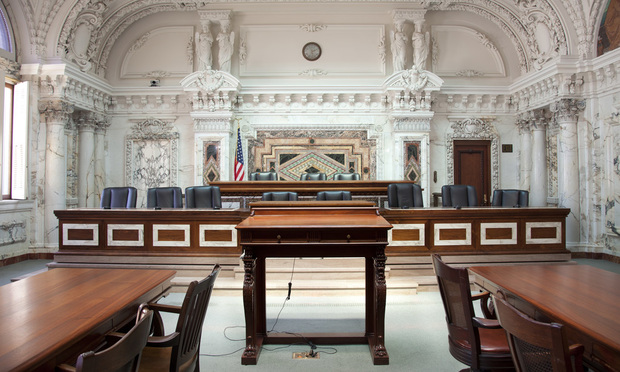Quiet Time? Oral Arguments Disappear in Federal Appeals Courts
The number and percentage of cases argued at the federal appellate level is fading leaving firms to ask where their next generation of appellate lawyers can turn for courtroom experience.
May 30, 2018 at 06:00 PM
9 minute read
The original version of this story was published on National Law Journal
 An empty podium at the U.S. Court of Appeals for the Ninth Circuit. (Photo: Jason Doiy/ALM)
An empty podium at the U.S. Court of Appeals for the Ninth Circuit. (Photo: Jason Doiy/ALM)
Oral arguments before federal appellate panels are where marquee partners at the nation's top firms make their clients' cases, cement their reputations and earn their four-figure billing rates.
But with oral argument increasingly falling out of favor with most federal appellate courts, the opportunities to stand up in court and plead a case are lessening. The most recent year statistics available from the Administrative Office of the U.S. Courts—the 12-month period ending Sep., 30, 2017—had just 6,913 arguments out of the 34,561 appeals decided on the merits. That 20 percent is a far cry from the 27.3 percent of all cases a decade ago (8,662 arguments heard), and an even more steep decline from the 40.1 percent of cases (10,357 arguments heard) just 20 years ago—when oral argument data became available from the Administrative Office.
Reed Smith partner James Martin, who helped lead a study about the flagging number of arguments for the American Academy of Appellate Lawyers titled “Wither Oral Argument?”, concedes that preparing for argument eats into court time and resources. But, he said that “systemically oral argument is important” beyond its impact on the outcome of any given case.
“I think that there needs to be a recognition by advocates that not every case deserves argument,” said Martin, who is based in Pittsburgh and Los Angeles. “But there needs to be a concomitant recognition by the courts that more cases should be argued than not.”
Martin and other members of the AAAL's Oral Argument Initiative met with judges on eight of the country's circuit courts over the past few years and developed a set of recommendations for how the courts could “resurrect” the culture of oral argument. They transmitted their findings to U.S. Chief Justice John Roberts Jr. and the chief judges of the circuit courts last year.
“Oral argument is, after all, the only time where a party and its advocate can interact with the decision-maker,” the report said, going on to call oral argument “the most tangible manifestation of the critical role that appellate courts play in the resolution of public and private disputes traversing our legal system.”
The report then prescribes steps lawyers and courts can take to make arguments a more useful and regular part of federal appellate practice. Will the nudge from the nation's top appellate advocates spur courts to hear more arguments? Martin said he thinks that's “an open question.”
“You're not going to get any judge to say 'We don't need [argument],” Martin said. “But the percentages at some level speak to it themselves.”
Why Not Argue?
Any judge or clerk will tell you that preparing for oral argument takes more time than deciding a case on the briefs. Time that judges and their clerks spend writing bench memos, testing potential questions, and, in some instances, traveling to distant courthouses to hear arguments, takes away from time to write opinions and dispose of cases.
In an op-ed in The New York Times last year, Judge William Pryor of the U.S. Court of Appeals for the Eleventh Circuit wrote that “hearing oral arguments and issuing published opinions in most [cases] would only delay decisions that should be speedy.” Pryor noted that although current caseloads are heavier than in the past, the nation's appeals courts have streamlined the way they make decisions. Circuit judges, he wrote, have technology that allows them to research and write opinions much faster than in the past and they have access to professional staff in addition to clerical support.
Pryor also pointed out a fact that might sting some appellate lawyers in private practice: “Fewer oral arguments mean lower attorneys' fees for litigants.”
But time and cost aren't the only reasons judges have cited for the decline in arguments. In an interview with National Law Journal affiliate law.com last year, Third Circuit Chief Judge D. Brooks Smith said federal courts had seen a “demonstrable decline” in caseloads and civil litigation since the Great Recession. Laurie Webb Daniel, the chair of Holland & Knight's national appellate team and leader of the firm's Atlanta litigation practice, said that the judges she spoke with as part of AAAL's oral argument initiative often said they declined to hear arguments because it didn't affect their cases' outcome.
“It may help to explain the case, help them write an opinion,” said Daniel in an interview with the Daily Report, another NLJ affiliate. “But in most cases, it doesn't really change their mind.”
Making a Case for Oral Argument
Still, appellate litigators say that focusing on the lack of cases where arguments change outcomes misses some of the vital purposes it serves in the appellate system. Mary-Christine “M.C.” Sungaila, a partner in the Costa Mesa, California, office of Haynes and Boone, said that arguments are most important to the parties themselves. “As a party, honestly, that's the only part of the process you see,” she said. “People may not agree with the result, but it's important to make sure they feel they've had their day in court and feel they've been heard, if not agreed with.”
Bruce Merenstein, the chair of the appellate practice group at Schnader Harrison Segal & Lewis, based in Philadelphia, agreed. Oral arguments, he said, allow clients “to see that the court is taking their case seriously.” But Merenstein added that advocates' focus on arguments can sometimes outpace their overall importance.
“To be perfectly frank, it's not the primary part of being an appellate lawyer,” Merenstein said, pointing to all the time he spends developing legal arguments, researching, deciding which issues to raise on appeal, and drafting briefs. “That's where most cases are won or lost.”
Still, other advocates point out that oral argument's effect can be corrective if not determinative. “Sometimes judges have a mistaken notion about what's actually happened in that case,” said Alan Morrison, the former director of the Public Citizen Litigation Group. “In oral argument, you get a last chance to correct that,” said Morrison, now the Lerner Family Associate Dean for Public Interest and Public Service Law at The George Washington University Law School.
Morrison said that the time preparing for argument and engaging with advocates without the distraction of computers or phones causes judges to focus in ways that they otherwise wouldn't. “Things happen to people who are sitting there,” Morrison said. “If that helps them learn better it's useful.”
Morrison handled the number crunching for the AAAL's project. He cautions that the raw numbers don't tell the whole story since many of the cases that aren't argued involve pro se criminal defendants, prisoner cases or immigration appeals where precedent clearly directs the outcome. “If you have a pro se case, you shouldn't look at it as the same thing as an EPA regulation case,” he said.
But even after factoring appeals that have been consolidated, according to Morrison's numbers there are wide variations from circuit-to-circuit. Only the D.C. Circuit and the Seventh Circuit hear anywhere near half of all competitive cases—45 and 55 percent respectively. The Third, Fourth, and Eleventh Circuits, meanwhile, hear arguments in less than 15 percent of cases.
The lack of argument, Morrison said, means that “we're losing the opportunities to train the next generation of oral advocates.”
Some in the circuit courts themselves have acknowledged that problem and have sought to create opportunities for newly minted lawyers to handle appeals. Haynes and Boone's Sungaila helped head up an American Bar Association litigation section subcommittee that put together a comprehensive guide to the pro bono opportunities available at each of the circuit courts—opportunities that often lead to the chance to argue. While larger circuits tend to have highly organized and competitive processes for choosing pro bono counsel in certain cases, some smaller circuits keep informal lists of individual lawyers and firms who have reached out by letter to the chief judge to express interest in helping out pro bono when needed.
Sungaila's home circuit, the Ninth Circuit, refers cases to pro bono counsel in immigration and pro se matters that staff lawyers and judges flag as presenting significant legal issues. “They're not saying they're winners, but they do identify that this has a meaty issue and that 'We would benefit from having counsel on both sides,'” Sungaila said.
Sungaila, who also teaches a Loyola Law School appellate clinic, singled out a Ninth Circuit program that allows student law clinics to handle pro bono appeals. She said her students at Loyola argued at the same April session as those from University of Nevada, Las Vegas and University of California, Irvine clinics. Such programs, she admits, require a “pretty robust effort on the staff attorney side” that smaller circuits might not be able to invest.
Reed Smith's Martin said that adopting such pro bono initiatives is just one of the proposals that the AAAL has suggested could boost the number and quality of arguments. The group's report also encourages courts to embrace technology where appropriate to let lawyers and judges appear remotely and to use focus letters pre-argument to point the parties to the issues that would benefit from argument.
At the same time, Martin said that the onus is also on practitioners to make argument worthwhile for judges.
“The quality of the advocacy has to improve. That's a place where of course appellate lawyers have a role to play,” Martin said. “If we can raise the quality of the oral advocacy, I think the courts will be much more willing to engage.”
”We have to understand always that while we're users of the system it has to work for the people who are deciding cases.”
This content has been archived. It is available through our partners, LexisNexis® and Bloomberg Law.
To view this content, please continue to their sites.
Not a Lexis Subscriber?
Subscribe Now
Not a Bloomberg Law Subscriber?
Subscribe Now
NOT FOR REPRINT
© 2025 ALM Global, LLC, All Rights Reserved. Request academic re-use from www.copyright.com. All other uses, submit a request to [email protected]. For more information visit Asset & Logo Licensing.
You Might Like
View All
Shareholder Democracy? The Chatter Elon Musk’s Tesla Pay Case Is Spurring Between Lawyers and Clients
6 minute read
In-House Lawyers Are Focused on Employment and Cybersecurity Disputes, But Looking Out for Conflict Over AI

2024 Marked Growth On Top of Growth for Law Firm Litigation Practices. Is a Cooldown in the Offing for 2025?

Big Company Insiders See Technology-Related Disputes Teed Up for 2025
Trending Stories
- 122-Count Indictment Is Just the Start of SCOTUSBlog Atty's Legal Problems, Experts Say
- 2Judge Rejects Walgreens' Contractual Dispute Against Founder's Family Member
- 3FTC Sues PepsiCo for Alleged Price Break to Big-Box Retailer, Incurs Holyoak's Wrath
- 4Greenberg Traurig Litigation Co-Chair Returning After Three Years as US Attorney
- 5DC Circuit Rejects Jan. 6 Defendants’ Claim That Pepper Spray Isn't Dangerous Weapon
Who Got The Work
J. Brugh Lower of Gibbons has entered an appearance for industrial equipment supplier Devco Corporation in a pending trademark infringement lawsuit. The suit, accusing the defendant of selling knock-off Graco products, was filed Dec. 18 in New Jersey District Court by Rivkin Radler on behalf of Graco Inc. and Graco Minnesota. The case, assigned to U.S. District Judge Zahid N. Quraishi, is 3:24-cv-11294, Graco Inc. et al v. Devco Corporation.
Who Got The Work
Rebecca Maller-Stein and Kent A. Yalowitz of Arnold & Porter Kaye Scholer have entered their appearances for Hanaco Venture Capital and its executives, Lior Prosor and David Frankel, in a pending securities lawsuit. The action, filed on Dec. 24 in New York Southern District Court by Zell, Aron & Co. on behalf of Goldeneye Advisors, accuses the defendants of negligently and fraudulently managing the plaintiff's $1 million investment. The case, assigned to U.S. District Judge Vernon S. Broderick, is 1:24-cv-09918, Goldeneye Advisors, LLC v. Hanaco Venture Capital, Ltd. et al.
Who Got The Work
Attorneys from A&O Shearman has stepped in as defense counsel for Toronto-Dominion Bank and other defendants in a pending securities class action. The suit, filed Dec. 11 in New York Southern District Court by Bleichmar Fonti & Auld, accuses the defendants of concealing the bank's 'pervasive' deficiencies in regards to its compliance with the Bank Secrecy Act and the quality of its anti-money laundering controls. The case, assigned to U.S. District Judge Arun Subramanian, is 1:24-cv-09445, Gonzalez v. The Toronto-Dominion Bank et al.
Who Got The Work
Crown Castle International, a Pennsylvania company providing shared communications infrastructure, has turned to Luke D. Wolf of Gordon Rees Scully Mansukhani to fend off a pending breach-of-contract lawsuit. The court action, filed Nov. 25 in Michigan Eastern District Court by Hooper Hathaway PC on behalf of The Town Residences LLC, accuses Crown Castle of failing to transfer approximately $30,000 in utility payments from T-Mobile in breach of a roof-top lease and assignment agreement. The case, assigned to U.S. District Judge Susan K. Declercq, is 2:24-cv-13131, The Town Residences LLC v. T-Mobile US, Inc. et al.
Who Got The Work
Wilfred P. Coronato and Daniel M. Schwartz of McCarter & English have stepped in as defense counsel to Electrolux Home Products Inc. in a pending product liability lawsuit. The court action, filed Nov. 26 in New York Eastern District Court by Poulos Lopiccolo PC and Nagel Rice LLP on behalf of David Stern, alleges that the defendant's refrigerators’ drawers and shelving repeatedly break and fall apart within months after purchase. The case, assigned to U.S. District Judge Joan M. Azrack, is 2:24-cv-08204, Stern v. Electrolux Home Products, Inc.
Featured Firms
Law Offices of Gary Martin Hays & Associates, P.C.
(470) 294-1674
Law Offices of Mark E. Salomone
(857) 444-6468
Smith & Hassler
(713) 739-1250






